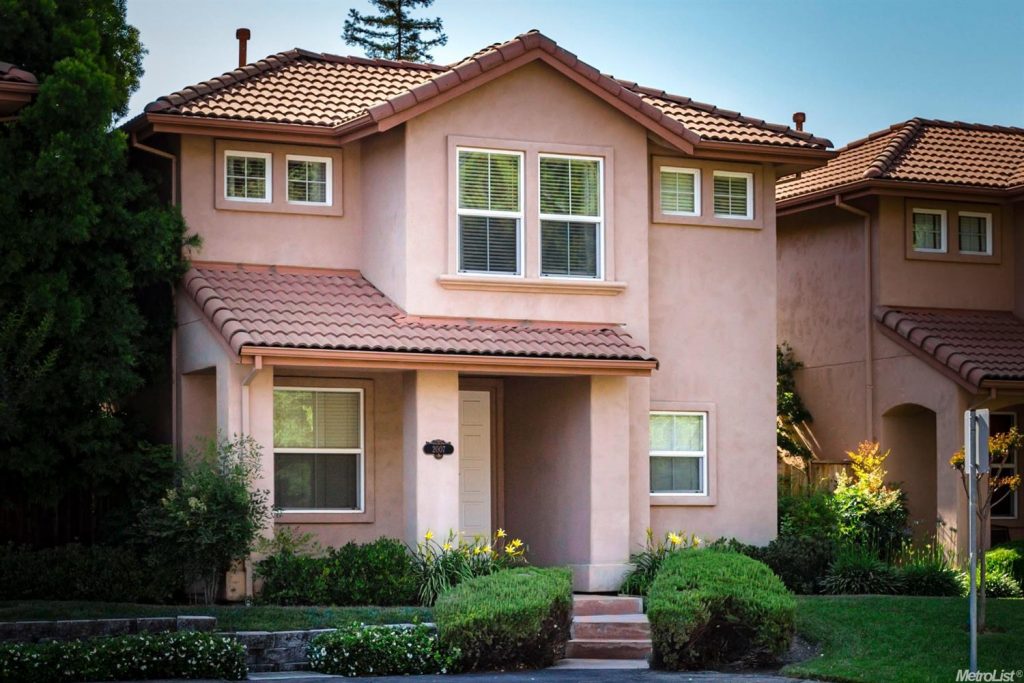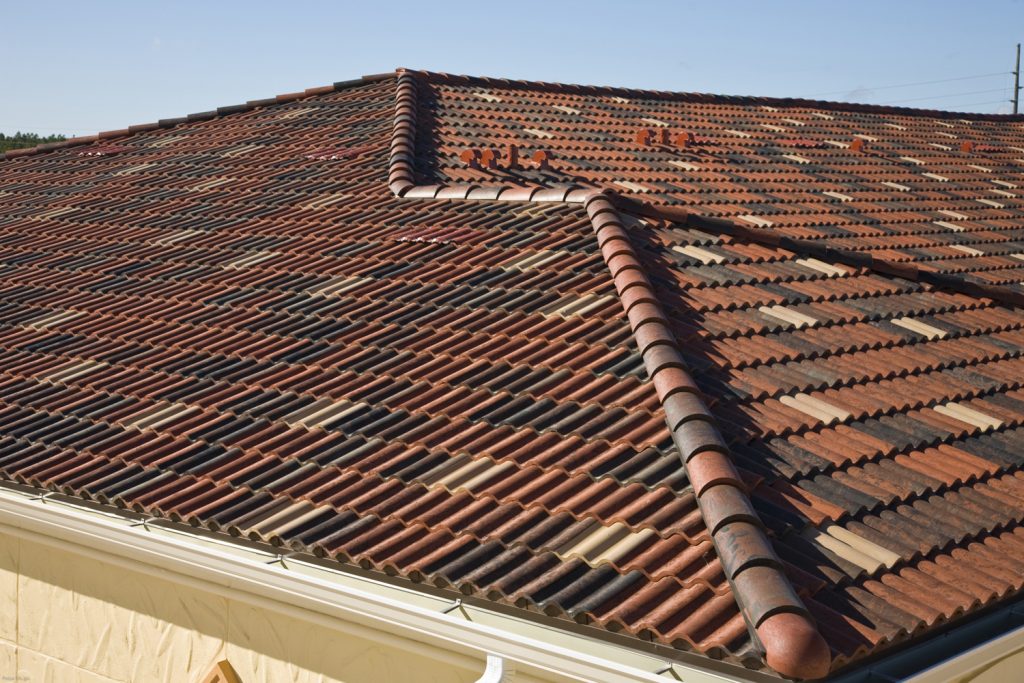In the US, tile roofs have been going in and out of style, but they’re guaranteed to last for quite a long while, providing a beautiful and distinct Mediterranean or Southwestern look and feel to a house (and its roof). Traditional tiles are normally made from either clay or concrete. The latter tends to be less expensive, but there is often more value and longevity in a clay tile roof.
Styles and Wide Variety of Tile Profiles
In North America, tile roofing is often associated with the southwestern US feeling. Deep red or Terracotta, Spanish-style clay tiles on a home with stucco siding is what normally comes to mind when we picture tile roofs. Yet, that’s just one possibility.
Historically, Dutch, and European immigrants have been in the business of importing clay tiles into the New World since about 1650.
All the way through the end of the 1700s, tiles were a very popular roofing material that was viewed as superior to wood, because it was fireproof, moss-and-algae-proof, far longer-lasting, etc.
By the mid-1700s, America had established itself as a country able to manufacture glazed and unglazed or uncoated tiles.
As the industrial age chugged along, corrugated metal roofing started to grow in popularity, which lead to the decline in the dominance of the clay tile market.
Metal is as durable and, in many cases, less expensive than tiles. Yet, there have been at least two clay tile revival periods in the last 200 years, which is why tile roofing has never lost its stature and appeal in the overall premium sloped roofing category.
Cement or Concrete vs. Clay Roof Tiles: Impact on Colors
While clay is the historic and predominant material, concrete is the other primary material option. Clay tiles normally come in two types: glazed (liquid glass baked onto the tile) or unglazed.
Clay tiles tend to hold color much better than cement tiles, especially in the case of Terracotta clay.
Regardless of the material, color is mixed in with the material during the production. With cement, color will fade somewhere between 30 and 50 years. With clay, the color will hold steady for 50 to 70 years. And with Terracotta, it is indefinite, or for sure, 100+ years.
Adding in tile shape and texture, provides a rather limitless variety of options. But generally, architects go for more popular and established styles like Terra-cotta barrel vault tiles, although flat tiles are also common, especially in more wind-prone areas where their low-profile can be beneficial.
Multi-colored tiles on a roof are an option that goes somewhat against the historic norms. Accessories are part of the installation, such that tiles shaped and formed for ridges, hips and gable ends add even more opportunity for greater variety.
Cost and Value
Cost of Materials: Concrete and Clay Tiles
Nailing down the exact cost can be a bit challenging. If tiles are plentiful in your region, then expect to pay anywhere from $4.50 to $10.50 per sq. ft. for a range of concrete tile options, EXCLUDING installation.
Note that concrete tiles can be made as either heavy or lightweight and are available in a wide variety of colors and shapes. Though again, uncoated, or unglazed cement or concrete tiles will not hold color as well as clay.
Clay tiles will cost anywhere from $6.00 to $14.50 per sq. ft. for materials. The rather wide material cost range reflects how premium a specific tile design can be. Other research shows that on average, clay tiles will cost anywhere from 10% to 30% more than concrete tiles.
Total Cost Installed
On average, concrete tiles will cost between $10.00 and $20.00 per sq. ft. installed, while clay tiles will cost between $12.50 and $25.00 per sq. ft. to install on a typical sloped roof.
If choosing a more sophisticated tile design or installing tiles on a tall and complex roof structure, the cost range can go up to $25.00 to $30.00 per sq. ft. installed, thus bringing it on par and/or making it more expensive than natural slate or even the ultra-premium copper roofing.
For a home that has a roof size of about 2,000 sq. ft., the overall average installation cost can range from $25,000 to $45,000 depending on the choice of materials, roof complexity, and home’s location.
Should you decide to go for a high-end tile roof, a premium clay tile roof on a similarly-sized home, could cost as much as $45,000 to $65,000 to install.
Structural Requirements
Before you can install clay or concrete tile roof, it is best to have your home inspected by an engineer to ensure it can hold the extra weight that comes with standard concrete and clay material.
While asphalt shingles weigh about 250 to 400 lbs. per square (100 sq. ft.), concrete tips the scale at 950 to 1200 pounds per square, so up to 5 times the weight.
Therefore, unless your roof frame was specifically designed to carry the weight of heavy tiles, it will likely require structural reinforcement.
Benefits
But the benefits are enormous. At the top is longevity. Clay and concrete will last a good 50 years minimum and exceeding 100 years is certainly possible with proper installation. To get the kind of longevity tiles can provide, you will need to hire an experienced tile roofer.
Allowing a handyman to do the job will might help save some money upfront, but this might lead to problems later down the line. Furthermore, having anyone who is not experienced with how to properly traverse the roof can lead to broken tiles.
While clay and concrete tiles are undoubtedly durable over the long haul, the material itself is a bit fragile in terms of impact resistance from full body weight.
Clay and Concrete Tiles vs. Natural Slate
Stone is rather impervious to water. Clay has water absorption of about 6%, while Concrete can absorb as much as 13%. Slate is a material that edges out clay, while wood is known to be rather poor in this regard. There are more benefits, and even disadvantages, which we’ll cover below.
Pros
- Superior longevity and durability – concrete tiles will last 50+ years, clay tiles will last 75+ years with proper maintenance
- Virtually waterproof, insect proof, fireproof, and resists rotting
- Low to almost no maintenance, though see Disadvantage with regards to roofing underlayment
- Wonderful variety of styles, colors, and profiles — very unique and beautiful appearance — color that will last (if going with clay tiles)
Cons
- Fragile when walked on, tiles can break rather easily
- Underlayment material won’t last as long as the material, and so that underlayment needs to be replaced even while the roofing tiles will be fine. A roofer would remove all tiles, replace underlayment material, and then re-install old tiles over the new underlayment – This can be extremely costly! It’s recommended to use high-performance breathable synthetic underlayment for improved underlayment performance and longevity
- Tiles are some of the more expensive roofing materials that most homeowners probably cannot afford
- The extra weight is significant enough factor that tiles may not work for every home, unless the roof frame is reinforced to bear the weight of tiles


I’m in the process of building a Tuscan type house in Prescott, AZ. It’s about 5,000 feet of elevation. The builder doesn’t suggest clay tiles because of the weather elements. Is he correct? I really want to use clay tiles. Please help.
So, using clay tiles in Arizona should be fine provided the roof frame can support the weight of the tiles and that the installer knows how to install roof tiles correctly. Clay tiles have a great track record of success in standing up to the elements.
The builder probably doesn’t want to deal with the headache of having to worry about the roof frame reinforcement and then having to find an experienced installer to install the clay tiles the right ways. If that’s the case, then this is really a question of convenience and doing the same old thing for the builder, it’s not about the durability of tiles.